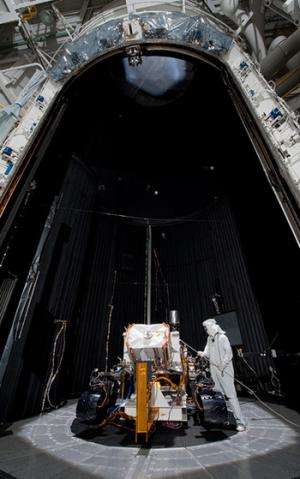JPL's space simulator today

(Phys.org)—You could call it the Ultimate Evil Tanning Bed—a stainless-steel torture chamber 47 feet tall and 25 feet in diameter that's expressly designed to deliver a fatal sunburn, if at all possible, to anything placed within. The chamber mimics the incredibly intense sunlight found in the vicinity of Venus, and it was built to see whether a spacecraft could withstand being seared on one side and frozen on the other. Would electronics fry as the solder melted? Would struts snap from the stress of plunging from dazzle to darkness and back again? Could you insulate your way to safety, or would you have to go back and find clever ways to get rid of the excess heat?
In 1962, E&S announced that "Caltech's Jet Propulsion Laboratory has just completed a 4-million-dollar space simulator which will be used to determine the ultimate design of lunar and planetary spacecraft that JPL is developing for the National Aeronautics and Space Administration." (NASA was not quite four years old then, and its acronym had yet to become a household name.) The vacuum chamber, the article boasted, was "large enough to test the complete spacecraft in its flight configuration," extended solar panels and all. In fact, the simulator was already in business—"a temperature-control model of the Mariner spacecraft is now being tested," the story noted, and the Venus-bound Mariner itself "will soon enter the chamber for many weeks of testing before the actual launching."
After enduring every punishment that JPL's engineers could devise, Mariner was declared good to go. Unfortunately, many things can go wrong with a launch besides the spacecraft, and on July 22, Mariner was blown up by Cape Canaveral's range safety officer within five minutes of liftoff after a typo in the guidance program allowed the rocket to veer off course. Fortunately, JPL had built a spare, and Mariner 2 became the world's first successful interplanetary mission when it buzzed Venus on December 14, 1962.
In the 50 years since, every spacecraft built at JPL has done hard time in the space simulator before being dispatched into the real thing. "It's a rare thing when a spacecraft goes into the simulator and the engineers don't learn something important and modify the design to work better," says Andrew Rose, the technical manager for JPL's Environmental Test Laboratory group.
The simulator proved so valuable that it got a major upgrade after the first couple of missions, Rose says. By 1965, the chamber's height had been bumped up to 86 feet, and the 133 original 2.5-kilowatt lamps and their focusing mirrors up in the solar dome were replaced by a 23-ton mirror suspended from the ceiling. This collimating mirror collects the light from 37 xenon lamps installed in a new "solar basement," turning their turbocharged beams into a bundle of parallel rays beating mercilessly downward. (Just one of these 25-kilowatt lamps shines five times brighter than a helicopter's searchlight.)
A computerized control system replaced the original banks of heavy-duty industrial push-buttons in 1994. More important, says Rose: "We took out the 10 oil diffusion pumps and replaced them with cleaner cryogenic pumps. Changing from oil diffusion pumps to cryogenic pumps allows us to provide a clean chamber that meets the planetary-protection requirements for testing Mars landers. There's nothing more embarrassing than going to Mars looking for signs of life and finding out it arrived with you."
And yes, the Mars Science Laboratory—cruise stage, descent stage, rover, and all—took its turn in the hotbox before being shipped off to the Cape last June.
Read about JPL's Space Simulator in the March 1962 issue of E&S.
Provided by California Institute of Technology





















